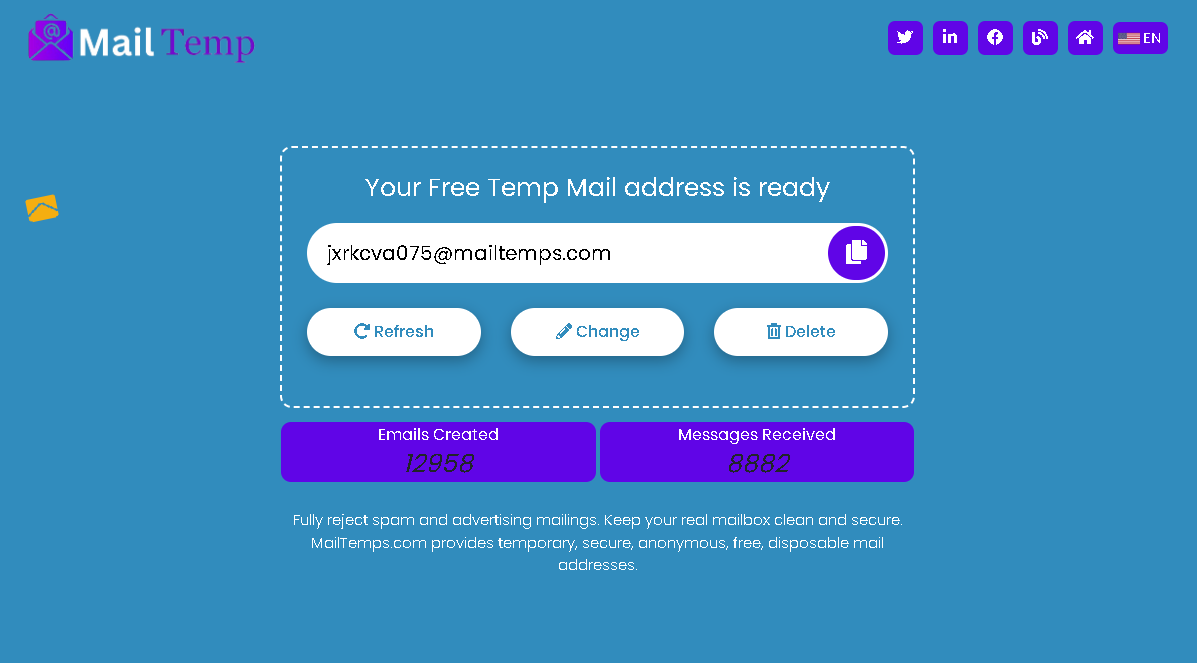In today’s digital world, online privacy and security have become more critical than ever. With an increasing number of people wanting to protect their email privacy and avoid spam, temporary email addresses have become a popular solution. But what exactly is a temporary email, and why is it so useful? This guide dives deep into the world of temporary email addresses in 2024-2025, covering everything you need to know—from how they work and when to use them to choosing the best services and understanding privacy implications.
What is Temporary Email?
Temporary email, often referred to as “temp mail” or “disposable email,” is an email service that provides users with a short-lived email address, usually lasting from 10 minutes to a few hours. Unlike regular email accounts, these addresses are designed for temporary use and are not tied to personal data, providing an easy way to interact online without revealing your actual email address.
Temporary emails are often used to receive one-time messages, activation codes, or short-term correspondence and are deleted automatically after a specified period. This makes them ideal for situations where long-term email access isn’t necessary.
Why Temporary Email is More Popular Now?
With privacy concerns and cybersecurity threats increasing every year, people are becoming more aware of the need for online privacy. As online marketing tactics evolve, so does the risk of personal email addresses being flooded with spam, phishing attempts, or unwanted newsletters. Temporary emails offer a convenient way to avoid such risks, keeping your primary email account free from clutter. The rise of online shopping, sign-up incentives, and short-term digital interactions has made temp mail a popular tool for managing online interactions without compromising personal information.
How Temporary Email Works
Temporary email services generate random email addresses instantly upon a user’s request. The process involves creating a unique email for a short period, which users can access without needing to sign up. Emails sent to this address are accessible via a temporary inbox, where they can be read, used, and, in some cases, replied to.
Key Differences Between Temporary and Regular Email
- Duration: Temporary emails last from a few minutes to several hours, while regular emails remain active as long as you maintain the account.
- Privacy: No personal details are needed to create a temporary email, ensuring a high level of anonymity.
- Intended Use: Regular emails are meant for ongoing communication, whereas temporary emails are often used for one-time verification or anonymous actions.
Why Use Temporary Email?
Temporary email addresses offer various benefits that make them a practical solution for modern internet users. Here are some of the primary reasons why people opt for temp mail services:
Privacy Protection
When using a temporary email, you don’t need to worry about sharing personal information. This anonymity makes it harder for third parties to track or target you with personalized ads or intrusive marketing campaigns.
Avoiding Spam and Junk Mail
Temporary emails provide an effective shield against unwanted emails. By using a disposable email for newsletters or promotional offers, you can keep your primary inbox free from clutter and avoid spam.
Simplifying Online Account Sign-ups
If you only need to access a service once, such as downloading a resource or joining a webinar, a temporary email allows you to sign up without cluttering your inbox or risking your data privacy.
Pros and Cons of Using Temporary Email
While temporary email addresses offer clear benefits, they also come with potential drawbacks. Understanding both sides can help you make an informed choice.
Advantages
- Privacy and Security: Temporary emails help protect personal data, making it harder for hackers or companies to access your primary email.
- Convenience: Easy to create and dispose of as needed, without any commitment.
- Spam Prevention: Reduces spam in your primary inbox by using a temporary address for sign-ups and promotions.
Disadvantages
- Limited Duration: Temporary emails expire after a short period, which means you may lose access to verification codes or documents.
- Restricted Usage: Many platforms recognize and block temporary email addresses, limiting your access.
- No Recovery Option: Once deleted, the temporary email and its contents cannot be retrieved.
Best Use Cases for Temporary Emails in 2024-2025
Temporary emails are particularly useful in specific scenarios. Here are some common situations where disposable email services come in handy:
Online Shopping and Free Trials
Many e-commerce websites request email addresses for creating accounts or offering promotional discounts. Temporary emails allow you to enjoy discounts or trial offers without linking your primary email account.
One-Time Sign-ups and Promotions
For short-term engagements, such as signing up for events, online workshops, or e-books, temporary email provides a quick, convenient way to sign up without adding to your inbox.
Accessing Online Content
Some websites require users to enter an email address to access free content, like articles or reports. Temporary email lets you get what you need without the hassle of providing your real email address.
Popular Temporary Email Providers
With a range of temporary email providers available, here’s a look at some of the most popular options in 2024-2025:
1. 10 Minute Mail
Known for its simplicity, 10 Minute Mail provides a temporary email address that expires after 10 minutes. It’s ideal for quick transactions and offers an option to extend the time if needed.
2. Guerrilla Mail
Guerrilla Mail offers a more flexible expiration time, lasting up to an hour. It’s widely used for temporary email purposes, with extra features like inbox customization and optional self-destruction settings.
3. Temp Mail
Temp Mail is another popular option that allows users to set up disposable email addresses for as long as they need. With features like mobile app access and attachment support, Temp Mail is highly versatile.
How to Choose the Best Temporary Email Service for Your Needs
When selecting a temporary email provider, consider these factors to make the best choice:
Security Features
Check for services that offer security options like SSL encryption or advanced spam filters to protect your data.
Expiry Times
Some services offer more flexible expiry times, which can be useful if you need a temporary email for a slightly longer period.
Ease of Use
Consider user-friendly options that don’t require sign-ups or complex interfaces, especially if you need quick access.
Privacy Concerns and Temporary Email
Temporary emails offer anonymity, but they aren’t entirely risk-free. Understanding potential privacy issues can help you use them responsibly.
How Temporary Email Protects Your Privacy
By not linking to personal information, temporary email helps prevent companies from tracking you or targeting your primary email with unwanted ads.
Risks to Be Aware Of
Despite their benefits, temporary emails can also be used for spam or fraudulent activities, and some providers may lack sufficient security protections.
Security Tips for Using Temporary Email Safely
To maximize your safety when using temporary email, consider the following precautions:
Avoiding Phishing Attacks
Be cautious with any links or attachments received in a temporary inbox, as these could be phishing attempts from unverified sources.
Safeguarding Personal Information
Avoid sharing sensitive data via temporary email, as these accounts are generally less secure than regular email addresses.




